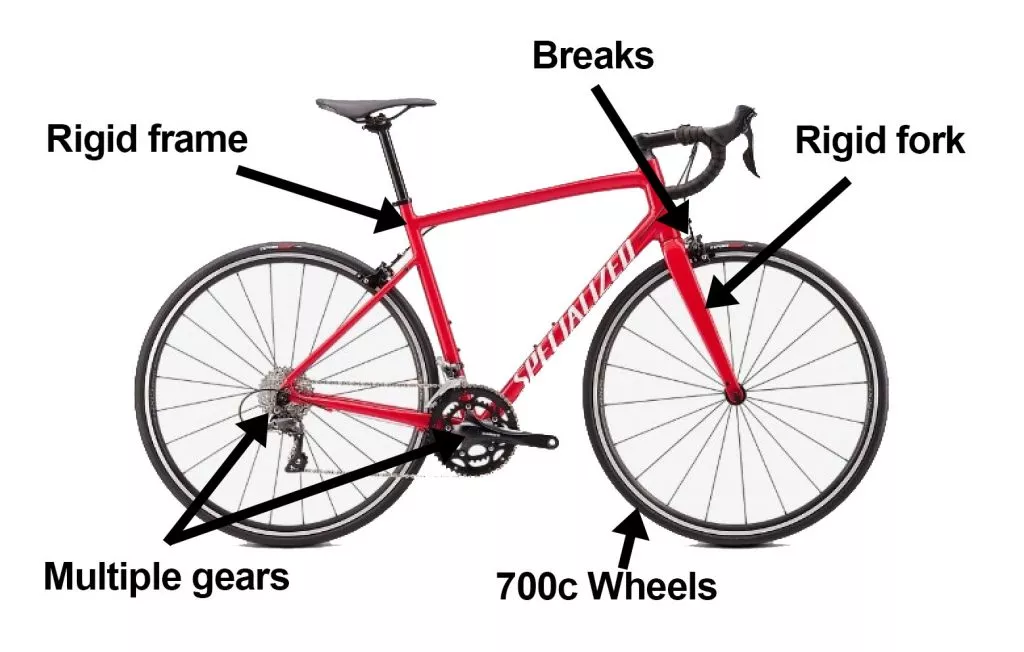Hybrid Bike: What is it and how to choose a Hybrid Bike
A hybrid bicycle, as the name suggests, is the offspring of a mountain bike and a road bike, resulting in a bike that excels in versatility. It’s this unique fusion that enables the hybrid to navigate through diverse terrain types, making it a popular choice for everyday commuting.
Hybrid Bicycle Features

Hybrid bikes are typically characterized by a shorter top tube, resulting in a more upright position that mirrors that of a mountain bike. In addition to this, they often sport flat handlebars, much like their mountain bike counterparts.
More off-road-oriented hybrids might include a suspension fork with a modest travel range, allowing for some gentle off-road cycling. These bikes also frequently come with the capacity to attach optional extras like pannier racks, making them a convenient option for commuting or leisurely rides.
Hybrid Bicycle Benefits

A significant advantage of owning a hybrid bike is its cost-effectiveness. They are usually more affordable than specialized road bikes or mountain bikes, both in terms of initial purchase and ongoing maintenance, due to their less complex and readily available parts.
But the real charm of a hybrid bike lies in its versatility. It does a commendable job both on and off the road, eliminating the need to buy two separate bikes. This dual functionality makes it an excellent choice for those uncertain about what kind of bike to invest in, or those who simply want the freedom to ride anywhere at any time. This ability to handle multiple terrains with a single purchase truly makes owning a hybrid bike a win-win situation.
Hybrid Bikes vs Road Bikes vs Mountain Bikes
| Bike Parts | Hybrid Bikes | Road Bikes | Mountain Bikes |
| Handlebars | Flat handlebars, allowing for an upright riding position. | Drop handlebars for aerodynamic riding position. | Flat or riser handlebars for aggressive riding position. |
| Tyres | Larger than road bikes, varies from road bike-like to mountain bike-like. | Narrow and smooth for high speed on tarmac. | Thick and knobby for grip on off-road trails. |
| Wheels | Varies, can be 26-inch (like mountain bikes) or 700c (like road bikes). | 700c, thin and lightweight for fast and efficient riding. | Typically 26-inch, wider and tougher for off-road terrain. |
| Braking System | Can vary, but often V-brakes or mechanical/hydraulic disc systems. | Rim or disc brakes, prioritizing lightweight and power. | Primarily disc brakes, designed for high stopping power. |
| Gearing | Versatile, can range widely depending on specific model. | High gears for high-speed riding. | Lower gear ratios for uphill and rough terrain. |
| Additional Features | Often comes with or compatible with mudguards and pannier racks. Some with suspension forks. | Designed to be lightweight, less commonly have extra features. | Often equipped with suspension for better off-road comfort. |
| Best Use | Versatile, good for mixed terrains and commuting. | Designed for speed and efficiency on paved roads. | Designed for off-road trails and rugged terrains. |
| Limitations | Not as fast as a road bike, not as off-road ready as a mountain bike. | Not suited for off-road or rugged terrains. | Not as fast or efficient on paved roads. |
The hybrid bicycle is a fusion of a mountain bike and a road bike, embodying features of both to accommodate a broad range of riding conditions. Notably, the hybrid boasts a flat handlebar, akin to those found on mountain bikes, as opposed to the drop bar standard on road bikes. This design, coupled with shifting and braking components reminiscent of mountain biking setups, facilitates a more upright riding posture. While this may curtail raw speed, it enhances comfort and visibility, crucial aspects when riding in traffic.
Moreover, hybrids commonly utilize larger tyres than road bikes, which translates to a smoother ride compared to narrower road bike tyres. However, hybrids are not all cut from the same cloth; some align more closely with mountain bikes, others with road bikes. Wheel size often serves as a good gauge of a hybrid’s leaning – those with 26-inch wheels, common on mountain bikes, are more suited for off-road adventures, whereas those with 700c wheels, typical of road bikes, are less off-road friendly.
The braking system on a hybrid can vary by model, with V-brakes and mechanical and hydraulic disc systems frequently encountered. As for gearing, hybrids tend to be versatile, often featuring triple chainsets and wide-ranging cassettes. Exceptions do exist, with some hybrids offering hub gears for low-maintenance long-distance riding, and others offering singlespeed variants for those who value simplicity.
It’s also worth noting that some hybrids come with full mudguards and pannier racks, and most are compatible with such addons, thanks to their built-in eyelets and clearances.
Suspension forks can be found on some hybrids. These provide an extra layer of comfort for bumpy routes but have limited utility for serious off-road biking.
While a hybrid bike is a versatile option, it’s crucial to understand its limitations. It’s not as fast as a road bike nor as off-road capable as a mountain bike. However, for those who want a bike capable of comfortably handling a mix of terrains, or for someone who occasionally switches between disciplines, a hybrid bike could be the perfect fit.
Can You Use a Hybrid Bike as a Road Bike?
You could certainly ride a hybrid bike as though it’s a road bike. While it may not match a road bike’s speed, it performs the task satisfactorily. Some hybrids even mimic road bikes more closely by featuring rigid forks, slimmer tires, and a lightweight construction from materials like aluminium and occasionally carbon fibre. These characteristics enhance their effectiveness as a road bike.
Ease of Riding: Road Bikes or Hybrids?
Although road bikes might seem ‘faster’ due to superior aerodynamics and high-end components that reduce drag, making them feel ‘easier’ to speed up on, hybrid bikes take the lead when it comes to comfort and control. The riding position on a hybrid is generally more relaxed, and the components are typically more user-friendly.
Are Hybrids Suitable for Beginners?
Hybrid bikes are an excellent choice for novices. Their wide tires offer stability for both on and off-road use, and their comfortable, upright riding position simplifies handling. Hybrids usually feature uncomplicated components, making them a perfect learning tool for newbies unfamiliar with bike mechanics. Also, they’re often more budget-friendly, which appeals to those beginners eager to dive into cycling without spending a fortune.
Can You Use a Hybrid for Long-Distance Rides?
If you’re after comfort and reliability for long-distance cycling, hybrid bikes are a solid choice. Thanks to a shorter top tube compared to road bikes, hybrids allow for an upright riding position, so you aren’t leaning forward too much. As a result, you’re likely to endure longer rides without back pain from an overextended posture.
Keep in mind, however, that hybrids are generally heavier than road bikes, which means you might need to exert more energy on your journey. Ultimately, the choice boils down to individual preference and comfort levels.
How to Choose Hybrid Bikes
Hybrid bikes are versatile machines, borrowing elements from mountain, road, and touring bikes to deliver a multi-purpose solution suitable for a variety of uses. Your ideal hybrid largely depends on its intended use. When hunting for a hybrid bike, you need to weigh up two main factors:
- Key Bike Features and Components: Factors like wheel size, suspension, gears, brakes, racks, and fenders influence how and where you can use the bike, and how it will perform.
- Proper Bike Fit: Once you’ve fine-tuned your options, ensuring the bike fits you correctly is crucial.
Understanding Hybrid Bike Features
To determine the right hybrid bike for you, first identify your riding requirements: Will you commute in the city, ride paved roads for exercise, or tackle a combination of gravel and pavement? This knowledge helps you assess the specific features of a hybrid bike and whether it meets your riding needs.
Wheel Size
700c: This wheel size is the standard on most hybrid bikes. When choosing a hybrid bike, focus more on its type rather than worrying too much about the wheel size.
26 in.: Some hybrid bikes come with 26 in. wheels, a little smaller than the standard 700c wheels.
Gears
Bikes come in a vast range of gears, from one to 27 or more. Given the variety of chainring and cog combinations and their teeth count, it can quickly become complicated. To simplify, focus on your fitness level and the terrain you’ll ride on. If your routes include many hills and you find climbing tough, more gears would be beneficial. Conversely, if you’re a robust cyclist or stick to flat terrain, you won’t require as many low gears to ascend a hill. Therefore, fewer gears can suffice, helping to keep your bike light. Some hybrid bikes, known as single-speed bikes, come with only one speed and a freewheel mechanism in the rear hub for coasting as you would on a multi-geared standard bike.
Understanding Bike Suspension
Hybrid bikes don’t always come with suspension since suspension forks can increase the bike’s weight and decrease pedaling efficiency. This is why many riders who primarily cycle on smooth, paved paths choose bikes without suspension.
However, some hybrid bikes, mostly those designed for urban settings, do come with front suspension forks.
These can help absorb impact on the front wheel, making rides on uneven streets smoother.
Brake Types Explained
Hybrid bikes can come with either rim brakes or disc brakes.
Rim Brakes: These feature brake pads that grip onto the bike’s wheel rims. They’re economical, allow easy monitoring of brake pad wear, and make replacing worn pads simple. However, they do wear out the wheel rim over time, have less stopping power, and are less effective in wet or muddy conditions. They also require more effort to brake aggressively.
Disc Brakes: These brakes feature pads that grip onto a brake rotor attached to the wheel hub. There are two kinds of disc brakes: hydraulic and mechanical. Hydraulic disc brakes offer stronger, smoother braking with less effort, and they self-adjust for brake pad wear.
Mechanical disc brakes, on the other hand, require manual adjusting as the pads wear.
Disc brakes offer consistent braking in all conditions, are cheaper to replace than a whole wheel, and perform better in steep and wet terrain. They also require less finger strain. However, inspecting pad wear and replacing pads can be more challenging, and hydraulic brakes can be more expensive to service.
Choosing the Right Bike Frame Material
Most bikes are made of aluminum, but steel and carbon fiber are also common. Each material has its advantages and disadvantages, and your decision should be based on your personal priorities.
Aluminum is lightweight, strong, stiff, and budget-friendly. While it can feel a bit harsh on bumpy roads, modern construction techniques have improved its shock absorption.
Steel is heavier than aluminum, but its strength and level of flex provide a comfortable, smooth ride.
Carbon fiber is lighter than aluminum and stronger than steel. It’s more expensive, making it a choice for high-end bikes. Some bikes use carbon fiber for forks and/or seat posts instead of an entire frame to keep costs down while still offering the benefits of this light, robust material. For more information, consider reading our article Understanding Bike Frame Materials.
